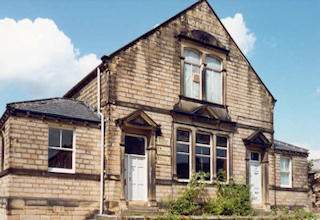Mirfield Chapels
The Trinity Methodists
The Trinity Methodist Church was established in 1833 when four prominent local Methodists, Messrs. Medley, R. Terry, Darley and W. Whiteley left the Wesleyan Methodist Society. The approached the Methodist new Connection at Huddersfield and as a result Mirfield became a part of it. The few Mirfield members started to hold meetings in a room at Hopton provided by Mr. Henry Wheatley. Soon however, it was required for business purposes and, few as they were, the new Connection people decided to build their own headquarters.
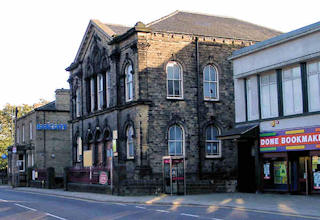
Trinity Methodist Church
The subscription list yielded a most useful sum and a plot of land in Eastthorpe was bought and plans prepared for a chapel. Less than 12 months after laying the foundation stone, the building was opened.
The chapel and land cost about £1,600, and although only a quarter of this had been raised at the opening, the little band of members soon attracted larger congregations who bought a new organ for £60 and installed it free of debt.
In 1843 their prosperity came temporarily to a stop. The Rev. Joseph Barker was expelled from the Methodist New Connection ministry and as a result of this many members left Trinity. The church remained in a continuous state of depression for over 20 years. This depression was broken when in 1861, a well-to-do local man, Mr Marmaduke Fox, who lived at Marmaville, at the bottom of Church Lane defrayed the cost of employing a new minister.
The Rev. T. Scowby arrived and the church made progress once more with 40 new members quickly joining. A new organ was bought for £160.
In 1871, the manse was built and furnished for £680. The church and Sunday School were attracting such numbers that a new chapel was needed. The foundation stones were laid on Easter Monday, 1877, on the site of the earlier building that had been demolished. Nearly 2,500 attended the ceremony. Four memorial stones were laid by Mrs. D. Armitage and Miss F. Hirst, of Dewsbury, Mr. Fox and Mr. Wilkinson, a well-known Mirfield businessman.
Under the stones were placed a bottle containing a plan of the circuit, a programme of the day's proceedings, a list of the trustees and contractors, a copy of the minutes of the recent Conference held at Dewsbury, a copy of The Reporter and several coins. Sunday School scholars made a collection among those present and laid the money on the memorial stones.
After the ceremony, tea was provided at the Town Hall across the road (now the home of the Salvation Army) and it was announced that Mr. Fox had given £400 and Mr. Wilkinson £200. Altogether more than £2,000 had been raised towards the £4,701 cost of the church which was dedicated on March 28, 1878. There is a record of a four-day bazaar held in the Town Hall which raised the very considerable sum of £670, and among the listed attractions were "a stall laden with choice plants and in the middle of it a miniature fountain which played all day"; a picture gallery; a museum; a waxworks show and Hilton's Band.
Mr. Fox gave another £500 and a further £4,000 towards a later bazaar held in 1884 and not long afterwards the debt was cleared off entirely.
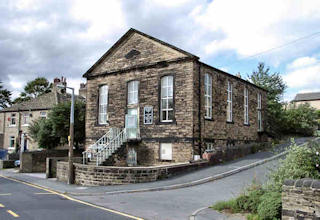
Methodist Chapel at Nab Lane
A small chapel at New Scarborough had been opened in 1873 and had enjoyed a vigorous life for some years but after 1920 its congregation joined that of Trinity.
The Methodist chapel at the bottom of Nab Lane has now closed.
The Moravian Church
The Moravian Church had its origins in Germany. The first moves to establish the Moravian Church in Yorkshire occurred in 1738 when a Moravian emigrant named Toeltschig arrived in the county and with a compatriot named Boehler, began to spread the teachings of the Brethren. By 1742 at least 1,000 people in the county had become Moravian adherents.
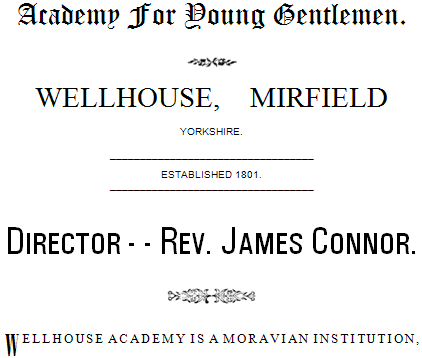
in the extensive and respectable Village
of MIRFIELD, which has long been noted for its beautiful and healthy situation in the picturesque
valley of the Calder.
It is about Twenty-five Minutes' walk from the Mirfield Station, on the
Manchester and Leeds Railway.
The above Institution provides a SOUND, COMMERCIAL, LIBERAL and RELIGIOUS EDUCATION FOR YOUNG GENTLEMEN from Eight to Sixteen Years of Age.
For the acquisition of the FRENCH and GERMAN LANGUAGES, superior facilities are offered.
FOR TERMS, &c., APPLY TO THE DIRECTOR
They held what were called love-fests for single men and single women and in the open air at Gomersal, there was a big gathering, at which everyone attending brought such food as they had. It was collected into one stock and placed on a large white cloth on the ground.
A verse was sung, and, after an address, stewards distributed the "feast" equally among the worshippers whose devotions lasted for 4 hours from 2 p.m.
By 1743 there were eight houses in Mirfield and Hightown where the Brethren were meeting, but they were already meeting with opposition. Sometimes they were accused of being Jesuits; then they were suspected of opposing the Throne and the Commonwealth. One of their ministers was arrested while preaching in Lee Green, Mirfield, and transported to York Castle. However, he was acquitted and discharged. There were other problems though and friction developed between the Brethren and the Wesleyans.
In 1751, a private house was rented and opened for worship by the Rev. Benjamin La Trobe, a name honoured then and subsequently for generations among Mirfield Moravians. That had to vacated soon afterwards, but four years later, a permanent lease of premises was obtained. In 1801 the boys' boarding school was built. Its pupils, from various parts of the country, were to include a future Liberal Prime Minister, Mr. H. H. Asquith. In its first 50 years, it had a total of 52 teachers at various times, of whom about 20 became Moravian ministers, and it taught 650 pupils.
The foundation stone of the Wellhouse Moravian Church was laid on April 16, 1800. In a lead box, buried beneath the stone, was placed an inscription which gave the names of every one of the 65 members of "the Brethren's Congregation at Mirfield, belonging to Protestant Episcopal Church of the Unity of Brethren." The building opened exactly one year later, again on April 16. The first Sunday School was built in 1826, to be replaced in 1890 by a larger building; the manse was built in 1837.
The Germanic origins of the Moravian faith are indicated by the list of ministers at Wellhouse, in which we find names like Gottlieb Hauptman, Jno. Ockershansen and Augustus Pohlmann and Ignatius Traneker.
An earlier record shows that the burial ground was the last resting place of two youths from the South Seas, "Christian Mydo and Joseph Oley, who departed happily in 1863." How they found their way to Mirfield over 100 years ago is still a mystery.
The Baptist Chapel
Early meeting places of the Mirfield Zion Baptists were a sick room, two barns and a Grammar School. Their origins, in the early years of the 19th century, makes for a story of persistent zeal in the face of much adversity.
In 1816, Mrs. Ingham, who lived at Blake Hall, Mirfield, and who was the daughter of Dr. Evans, tutor at the Baptist College, Bristol, sometimes provided food and shelter for students who came from the Baptist Academy at Little Horton, Bradford, to preach at chapels in the surrounding areas.
One such student was a Mr. Charles Thompson, who, one Sunday evening in the summer, held a prayer meeting in the sick room of Mrs. Ingham, who had been confined to bed for some years. Besides Mrs. Ingham, the meeting was attended by Mr. James Clarkson, his sister Mary, and two women servants at Blake Hall. Three weeks later, they started to hold services at the Hall. The visiting student or minister, if the weather was fine, would speak from the steps leading to the kitchen, the worshippers standing on the flags outside.
If the weather was not fine the congregation moved into the kitchen. By the winter of 1816 the attendances had grown and the services were moved to the old Tithe Barn which used to stand near the Old Rectory off Pinfold Lane. However, they soon had to quit this venue as the whole of the barn was needed for crop storage. Mrs. Ingham had supplied six benches, at a cost of a guinea each, as she had heard that some of the older worshippers suffered through having to stand throughout the services.
Next, the Baptists moved into another barn, this time at Littlemoor which had previously been used by the Battyeford Primitive Methodists. It had no windows and a hole had been made in the roof to admit light. The Baptists paid £2 a year for this for two years.
They moved, in 1820, to the old Grammar School (part of which still exists at the Knowl) largely through the good offices of one of their members, Mr. Garside, who was also a teacher at the school and didn't care for the discomforts of the barn.
The first Baptist Church in Mirfield was formed on July 25, 1825. It had 15 members, all of them baptised by immersion. Their enthusiasm suffered something of a reverse when Mr. Garside was given notice to leave his teaching post and soon afterwards the Baptists were invited to find another meeting place.
The gathered for one Sunday meeting at the Knowl Wesleyan Schoolroom but for some reason that was their last meeting there and once again they were looking for another place. None was to be found, so Mr. Clarkson, who had taken part at the original gathering at Blake Hall, said they could use his house at the Nab. The morning service was held in the parlour, and in the afternoon, they moved the pulpit so that the larger congregation could sit in two rooms and still hear the preacher. They continued to meet in Mr. Clarkson's house for four years.
In 1828 they began to build a small chapel at the Knowl. They found it difficult to raise funds and Lockwood Baptists lent them funds on condition that the timber should be purchased in Hull. The collection at the stone laying raised 19s. 4d. Money was very hard to come by in those days. The chapel cost £1,050 and £800 was still owing when it opened. It was to be 1862 before the debt was cleared and the present Sunday School building was built that same year.
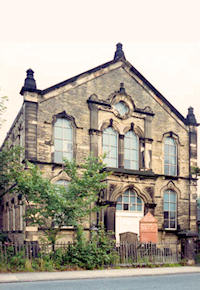
The old Baptist Chapel
By 1871, the old chapel had become too small and it was decided to build a new one. After the corner stone had been laid on September 13, 1871, about 500 attended a tea in the Town Hall. The cost of this chapel was £3,500 and it opened on Good Friday, April 11, 1873 free of debt. Mr. Josiah Berry, who laid the corner stone contributed £200 towards the cost, Mr. Henry Walker contributed £500 and his son £200 for the organ. In 1993 this building was deemed to be unsafe and was demolished. Services are now held in the Sunday School.
The first, and perhaps the most illustrious, of the Zion Baptist leaders was the Rev. Henry Seabrook Albrecht, pastor for 46 years from 1831. Mr. Albrecht was till a student when he took on the work of pastor at Mirfield's small struggling community. The building work on the chapel was at a standstill with four walls standing roofless. A Baptist historian has written about Mr. Albrecht's early struggles at Mirfield describing him as "poor, on many occasions having only an apple for his meal, clothes threadbare, yet clean. Almost shoeless, he worked on, preaching for years without salary, seeking donations and even giving his little mite to prevent the chapel coming to the auctioneer, for the ground on which that first chapel stood was not yet paid for. Once, when a church meeting was held to decide what means should be adopted, an old member said 'Sell'. The young minister rose with all the fire he possessed and said 'Would you sell the dead?' for some already rested in that old chapel yard."
It was not until the debt on the church was cleared that Mr. Albrecht's stipend was raised to £40 a year. By 1871 he was getting £2 a week. He resigned through ill health after 46 years service and died a few weeks later on December 9, 1877.
For information on the current Baptist Church visit their website at www.mirfieldbaptist.org.uk.
